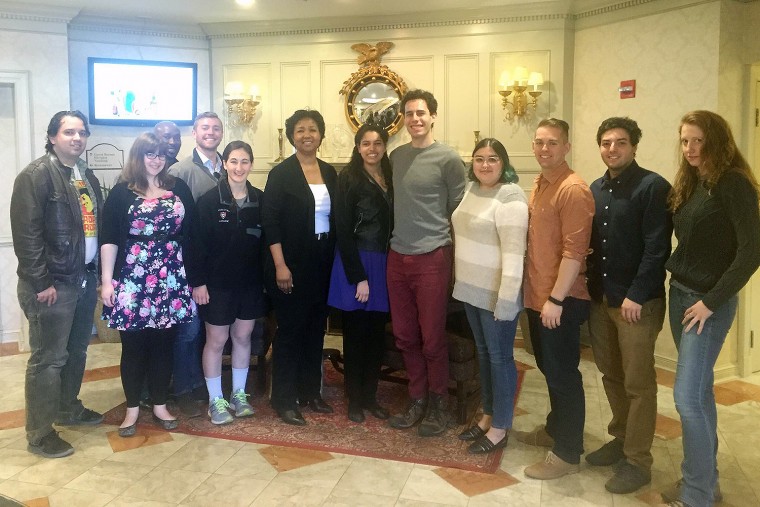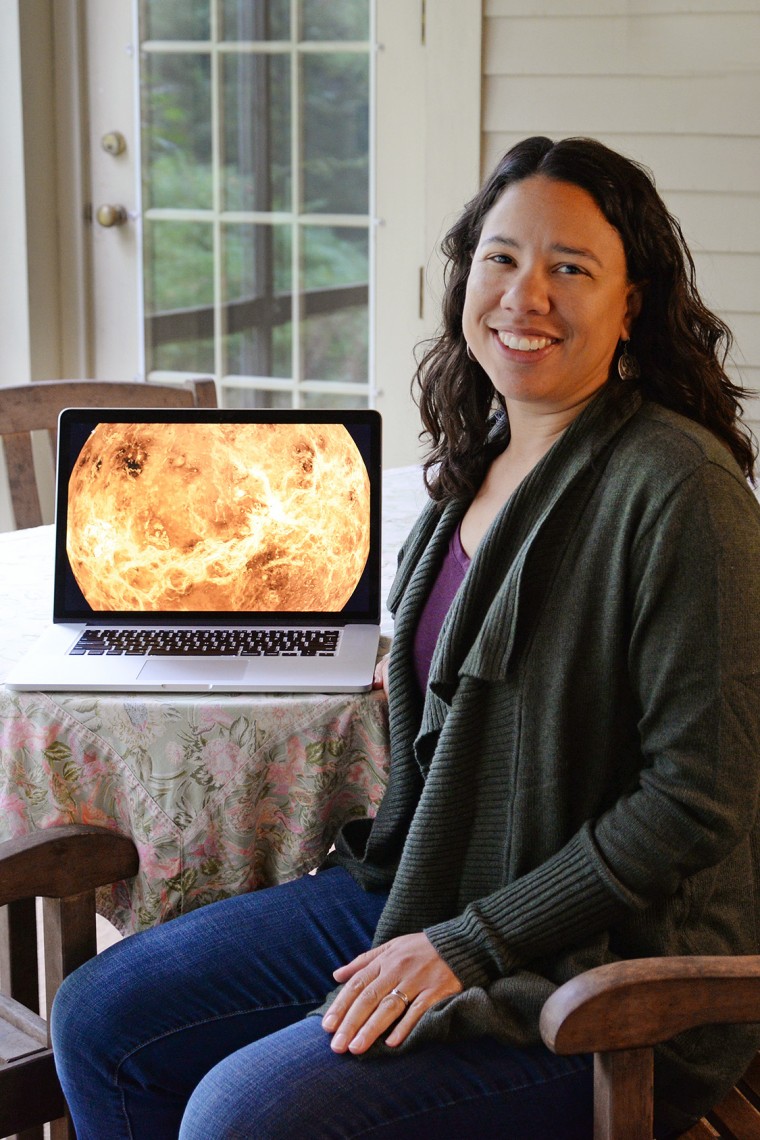Martha Gilmore, George I. Seney Professor of Geology, professor and chair of earth and environmental sciences, joined legendary astronaut and engineer Buzz Aldrin and Hoppy Price of NASA's Jet Propulsion Laboratory for a discussion on WNPR about the past, present and future of space exploration. The three were guests on The Colin McEnroe Show on May 25. Aldrin, who was one of the first two humans to walk on the moon, is the author of a new book, No Dream is Too High: Life Lessons From a Man Who Walked on the Moon. McEnroe asked Gilmore about our current level of understanding…
(more…)
Three Wesleyan students, faculty and several alumni recently attended the 47th Lunar and Planetary Science Conference in The Woodlands, Texas. This conference brings together international specialists in petrology, geochemistry, geophysics, geology and astronomy to present the latest results of research in planetary science. The five-day conference was organized by topical symposia and problem-oriented sessions. Earth and environmental sciences graduate students Ben McKeeby and Shaun Mahmood, and earth and environmental science major Melissa Lowe ’17 presented their ongoing planetary science research at the conference. Lowe received a NASA CT Space Grant travel award to attend the conference. McKeeby shared his research titled, "An investigation…
Two faculty members and three students have been awarded grants in the latest call for proposals from NASA's Connecticut Space Grant Consortium. Jim Greenwood, assistant professor of earth and environmental sciences, and Bill Herbst, the John Monroe Van Vleck Professor of Astronomy, professor of integrative sciences, were awarded $8,000 for a Faculty Collaboration Grant titled “Chondrule Formation Experiments.” This is to run high-temperature experiments on material that makes up meteorites in order to test a hypothesis that they put forward in a recent paper in Icarus this year. Seth Redfield, associate professor of astronomy, associate professor of integrative sciences, was awarded $1,500 for a STEM Education…
Johan "Joop" Varekamp, the Howard T. Stearns Professor in Earth Science, led an invited talk at the American Geophysical Union (AGU) meeting in San Francisco, Dec. 2015. The earth and space science community participated in discussions of emerging trends and the latest research. The session, which was co-authored by former Wesleyan E&ES graduate student Lauren Camfield, focused on the 2012 eruption of the Copahue volcano in Argentina. Due to the success of the invited talk on Volcanic Hydrothermal Systems, Varekamp will be a co-editor for a special issue of a journal based on that session. As part of his role as…
Bill Herbst, the John Monroe Van Vleck Professor of Astronomy, and James Greenwood, assistant professor of earth and environmental sciences, co-authored an article published in the planetary science journal Icarus. Their article, “A New Mechanism for Chondrule Formation: Radiative Heating by Hot Planetesimals” grew out of research seminars from the recently introduced Planetary Science graduate concentration and minor at Wesleyan. Their work focused on chondrules, or tiny spheres of molten rock that permeate primitive meteorites and date to very close to the beginning of the solar system. For decades, the existence of chondrules has puzzled astrophysicists and cosmochemists as no…
Kevin Flaherty, a postdoctoral researcher working with Meredith Hughes, assistant professor of astronomy, will speak on "Dusty Debris as a Window into New Planetary Systems" during the American Association for the Advancement of Science's (AAAS) 2016 Annual Meeting in Washington, D.C., Feb. 13. Flaherty is one of three symposium speakers who will discuss the theme "Planet Formation Seen with Radio Eyes." Scientists are now probing how, where, and when planets form and are analyzing the links between planetary system architecture and the properties of the parent circumstellar disk. Though the relationship of planetary to stellar masses remains obscure, it is clear that most…
Four Wesleyan undergraduates and a faculty member received awards in the latest call for proposals from NASA's Connecticut Space Grant Consortium. Astronomy major Rachel Aronow '17 was awarded an Undergraduate Research Fellowship in the amount of $5,000 for her project, "Planet Formation and Stellar Characteristics in Tatooine-like Systems." She is working with Bill Herbst, the John Monroe Van Vleck Professor of Astronomy, studying Tatooine-like systems (named after the fabled home system of Luke Skywalker), which are planet-forming disks that surround a close pair of stars that are in orbit around each other. Aronow conducted research with Herbst last summer, and these funds will support further…
The 26th Annual Undergraduate Research Symposium of the Keck Northeast Astronomy Consortium (KNAC) was held at Williams College on Oct. 17. Five students presented results of their summer research: Julian Dann '17, Aylin Garcia Soto '18, and Girish Duvvuri '17 delivered oral presentations while Rachel Aronow '17 and Avi Stein '17 presented a poster. Several other students came along to enjoy the weekend, which featured a dinner and social event on Friday night, the seminar on Saturday and breakout sessions on such topics as Inclusive Astronomy and how/why to program in Python. More than 100 students and faculty from KNAC attended the event (pictured…
On Sept. 30, NASA’s Discovery Program selected five planetary mission investigations for study during the next year as a first step in choosing one or two missions for launch as early as 2020. Wesleyan’s Martha Gilmore is on two of the investigation teams. Gilmore, the George I. Seney Professor of Geology and chair of the Department of Earth and Environmental Sciences, is an expert on terrestrial planets. She studies the morphology and mineralogy of the surfaces of Venus and Mars using data from orbiting and landed spacecraft. She also is on the Executive Committee of NASA’s Venus Exploration Analysis Group…
For her outstanding contributions to Milky Way research by observational methods, Meredith Hughes, assistant professor of astronomy, received the 2015 Bok Prize in Astronomy from Harvard University. The prize, named in honor of Astronomer Bart Bok (1906–1983), is awarded to a recent holder of a PhD degree in the physical sciences from Harvard or Radcliffe who is under 35 years of age. Hughes received her PhD from Harvard in 2010, and a MA in astronomy from Harvard in 2007. Hughes is an expert on planet formation, circumstellar disk structure and dynamics, gas and dust disk evolution and radio astronomy. She studies planet formation by observing…
Seth Redfield, associate professor of astronomy, and Marshall Johnson '11 are the co-authors of an article titled "The Interstellar Medium in the Kepler Search Volume," published in The Astrophysical Journal, Vol. 802, No. 2, July 2015. The article highlights ways scientists are studying the gas and dust in the galaxy near where the Kepler Space Telescope is discovering exoplanets. "Stars, with planets, can interact with the gas surrounding them in interesting ways, like bubbles in a drink, where each of the bubbles is an individual star (perhaps with planets) and the drink is the 'interstellar medium', the gas in between the stars," Redfield explained. In…





